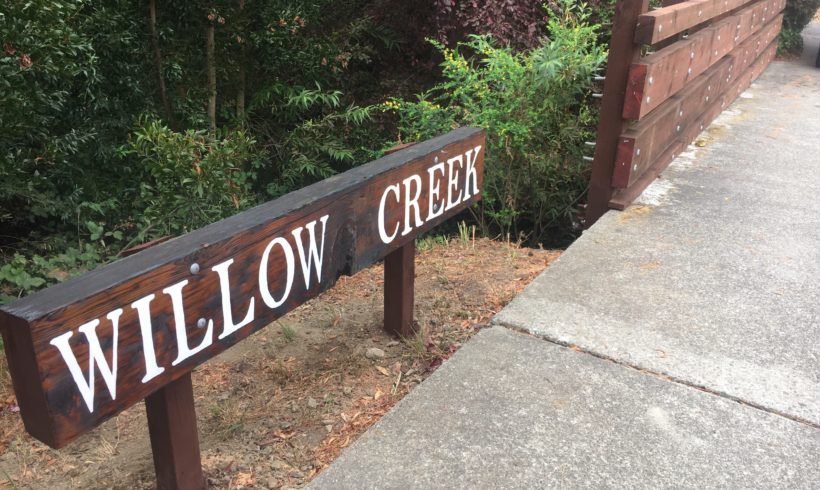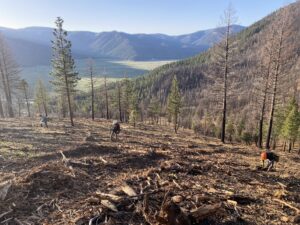Before the shoreline was lined with shipyards during World War II, creeks flowed through Sausalito in the North Bay—rare permanent streams in a dry state full of ephemeral ones. The trees that grew up around these creeks lent the city their name: “little willow grove,” or, in Spanish, Sausalito. But the name has long been ironic, as the creeks were forced into underground culverts in the name of progress. “The city’s development pattern was not to incorporate creeks into the urban design—but to cover them and bury them,” says Steve Moore, chair and founder of Friends of Willow Creek, a nonprofit community group that is working to bring them back.
Just to the southwest side of Bridgeway, a main drag through Sausalito, the friends group put up a new wooden sign with white lettering that marks the only uncovered portion of one such creek. There, Moore’s organization has been replanting native species and advocating to daylight Willow Creek since 2011. Such efforts to unbury creeks are popping up across the nation, as cities recognize the many services these waterways provide residents, like flood control, runoff filtration, and connection with nature.
But they are expensive. And until a recent flood of federal funding, breaking through the culverting at Willow Creek has been, so to speak, a pipe dream.

About this project: Bay Nature is reporting on funding for nature in BIL and IRA. Tell us what you think or send us a tip at wildbillions@baynature.org, and read more at our Wild Billions project page.
In June, the U.S. Environmental Protection Agency awarded $3 million to the Sausalito Marin City School District to bring that creek back aboveground at the Nevada campus of the district’s Dr. Martin Luther King Jr. Academy, which sits on top of one portion of the culverted creek. The money comes from the San Francisco Bay Water Quality Fund, an EPA grant program that got a big boost in federal dollars from the Bipartisan Infrastructure Law. The school, in partnership with the friends group, will use the funds to daylight around 600 feet of creek habitat, build new outdoor learning environments, and implement other green infrastructure, including a bioretention basin.

EPA has only recently begun funding school districts to act as land stewards, according to Luisa Valiela, the agency’s lead at the San Francisco Bay office, which administers the water quality fund. That’s partly because the fund prioritizes large-scale environmental change, she says. School projects are generally small. But BIL’s money was meant for underserved communities—which allowed the agency to select a more holistic project, like this one.
“We saw it as a very well-integrated approach to improving this corner of the world,” Valiela says: “They were addressing an important environmental restoration in an underserved community.” They had their ducks in a row, their partners lined up. And, not least, they owned the land they wanted to work on. “It was just an amazing opportunity, and we’re so fortunate to be able to support that.”
This could become a thing
In some ways, Valiela says, the MLK Academy’s project is a “unique opportunity.” How many schools have an ancient creek buried underneath their campus? But, more broadly, she says, similar projects could be funded in other school districts. As the agency looks for high-impact climate projects, EPA is starting to see schools as among the urban spaces that can be reimagined with less tarmac and more nature.
“We are paying attention to where we can really, really build climate resilience in other places and in other school districts that are ready for it,” Valiela says.
The project’s design, planning, and implementation will mostly be handled by the Friends of Willow Creek, but Moore says he’s more than happy for the district to “take credit for this brave thing [they’ll] never regret.” The hope, he says, is that more schools will be emboldened to see caring for the land they are built on as their responsibility.
LaResha Huffman, the school superintendent, is “all on board.” She says the creek daylighting will allow the school’s environment to more closely mirror a more natural ecosystem. “We’re trying to bridge the gap between just classroom instruction to actually being outside with nature, understanding nature,” she says.
A particularly good time for it
The grant came amid other big changes for the school. The state attorney general ordered the school in 2019 to desegregate its two campuses—a previously predominantly Black campus in Marin City, and an affluent, predominantly white campus in Sausalito, through which the underground Willow Creek runs. This year is the third year that the two formerly separate schools have been running as a combined K-8 with an upper and lower campus in Sausalito.

Right now, Huffman says the Nevada campus is being “completely rebuilt” using county-level Measure P bond funding, including building out new classrooms and changing the sewer infrastructure. The school district is also using that money to cost-match the federal grant, meaning $6 million in total will be devoted to the daylighting and bioretention project. While the daylighting portion is still in the contracting phase, the school’s sewage rework (and the green stormwater infrastructure) will happen over the course of 2024.
Just as the city’s pursuit of development pushed creeks underground, Friends of Willow Creek is now jumping at this period of re-development to unbury what had been lost. The funding for the bigger picture reconstruction “made it all possible,” Huffman says.
The plan evolved over time
The partnership between school and environmental advocates has, like a creek bed, occasionally been rocky. Moore, with Friends of Willow Creek, says creek advocates have learned to deal with the “transient” nature of a school community. As boards change and teachers and parents come and go, building a sustained effort can be a challenge.
Even the current plan—to daylight parts of the creek around the school while leaving the campus itself un-bisected—is a compromise. Originally, EPA had greenlighted a design that ran the creek through the campus, but district officials objected, worrying a student might get hurt. Eventually, they settled on a “perimeter” concept, and now plan to divert the creek’s original path along the northern boundaries of the school.

Valiela says such changes are par for the course, and ecologist Terri Thomas, a consultant for the Friends of Willow Creek project, says the newer design might even be better than the first. “There’s going to be more creek now than there was before,” Thomas says. It will meander more, too—a “slower kind of creek,” Thomas says—which may mean less erosion than the original design.
Building relationships with nature
Thomas, a National Park Service retiree who was drawn into the Willow Creek project for her experience with creek restoration, has seen firsthand how daylighting can restore a natural area. At the Presidio, where Thomas helped daylight three creeks in Tennessee Hollow, native plantings flipped the script for the area’s flora—from about 98 percent exotic plants to 94 percent native—in the span of seven years. With the return of native plants came an increase in local birds, like Anna’s hummingbirds and Wilson’s warblers, and a growth in the creek’s benthic biodiversity.
“Wouldn’t it be great for the kids to grow their own native plants, and to plant them, and to watch this creek, through time, evolve like that?” Thomas says.
Nathan Scripps, the science teacher at the middle school campus, takes his students on weekly walks into nature and encourages nature journaling, and recently teamed up with Bay Nature to get nature magazines into kids’ hands. He says he worries the next generation of climate stewards doesn’t have the same connection to nature that his does.
“Our youngest generation has no context and no understanding of what they are losing, because they have no memory of it,” he says. By providing elementary school students with a natural creek to grow up near, the hope is that they grow to care about it.
Thomas, too, believes the work of restoring that natural environment should be carried out, in part, by the local community: “You want them to feel invested,” she says. “So that it becomes their creek.”
Repairing the riparian
Just west of the proposed creek daylighting lies the Saucelito Creek Wildlife Refuge, where motion-activated cameras have captured gray foxes, coyotes, black-tailed deer, and California quail. But these animals are likely landlocked, according to a 2017 report for Open Space Sausalito—hemmed in by Highway 101 to the west. Daylighting the creek, and planting native plants along the banks, Moore says, will expand that wildlife corridor and support local biodiversity.
For Moore, Thomas, and other Friends of Willow Creek, the 600-foot restoration effort is just Phase “1A” of a grander, five-phase plan to unbury both upstream and downstream sections of the mile-long Willow Creek, with hopes of reaching the Bay. The land under which the culverted creek runs is mostly publicly owned (it includes the Sausalito shipyard, the city’s Corporation Yard, and some Caltrans property). In theory, that makes this kind of restoration work easier. Still, “it’s very ambitious,” Moore concedes. It will likely take years, and millions more dollars.
Whatever part of the creek remains buried will continue to run its course through underground concrete pipes. And the magic of Sausalito’s hydrology—a rare perennial creek system, supported by the excess vapor from coastal fog—will be prevented from breathing life into the land above.
“You can hear them talking,” Moore says, of Sausalito’s creeks. “Down in the catch basins, the manholes. The creeks have a music, and that’s what we’re trying to respond to.”





